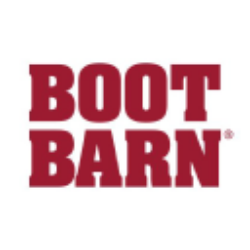FMP

Boot Barn Holdings, Inc.
BOOT
NYSE
Boot Barn Holdings, Inc., a lifestyle retail chain, operates specialty retail stores in the United States. The company's specialty retail stores offer western and work-related footwear, apparel, and accessories for men, women, and kids. It offers boots, shirts, jackets, hats, belts and belt buckles, handbags, western-style jewelry, rugged footwear, outerwear, overalls, denim, and flame-resistant and high-visibility clothing. The company also provides gifts and home merchandise. As of May 10, 2022, it operated 304 stores in 38 states. The company also sells its products through e-commerce websites, including bootbarn.com; sheplers.com; and countryoutfitter.com. The company was formerly known as WW Top Investment Corporation and changed its name to Boot Barn Holdings, Inc. in June 2014. Boot Barn Holdings, Inc. was founded in 1978 and is based in Irvine, California.
104.34 USD
-0.07 (-0.06709%)
Operating Data
Year
2020
2021
2022
2023
2024
2025
2026
2027
2028
2029
Revenue
845.58M
893.49M
1.49B
1.66B
1.67B
2.02B
2.44B
2.96B
3.58B
4.33B
Revenue %
-
5.67
66.57
11.38
0.57
21.04
21.04
21.04
21.04
Ebitda
126.1M
145.07M
325.01M
315.57M
249.19M
351M
424.86M
514.27M
622.5M
753.51M
Ebitda %
14.91
16.24
21.84
19.04
14.95
17.39
17.39
17.39
17.39
Ebit
73.62M
86.69M
258.37M
231.76M
199.61M
249.1M
301.53M
364.98M
441.79M
534.77M
Ebit %
8.71
9.7
17.36
13.98
11.97
12.35
12.35
12.35
12.35
Depreciation
52.47M
58.38M
66.64M
83.81M
49.59M
101.89M
123.33M
149.29M
180.71M
218.74M
Depreciation %
6.21
6.53
4.48
5.06
2.97
5.05
5.05
5.05
5.05
EBIT (Operating profit)(Operating income)(Operating earning) = GROSS MARGIN (REVENUE - COGS) - OPERATING EXPENSES (R&D, RENT) EBIT = (1*) (2*) -> operating process (leverage -> interest -> EBT -> tax -> net Income) EBITDA = GROSS MARGIN (REVENUE - COGS) - OPERATING EXPENSES (R&D, RENT) + Depreciation + amortization EBITA = (1*) (2*) (3*) (4*) company's CURRENT operating profitability (i.e., how much profit it makes with its present assets and its operations on the products it produces and sells, as well as providing a proxy for cash flow) -> performance of a company (1*) discounting the effects of interest payments from different forms of financing (by ignoring interest payments), (2*) political jurisdictions (by ignoring tax), collections of assets (by ignoring depreciation of assets), and different takeover histories (by ignoring amortization often stemming from goodwill) (3*) collections of assets (by ignoring depreciation of assets) (4*) different takeover histories (by ignoring amortization often stemming from goodwill)